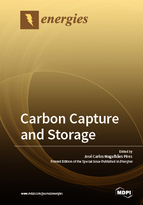Carbon Capture and Storage
A special issue of Energies (ISSN 1996-1073).
Deadline for manuscript submissions: closed (31 October 2018) | Viewed by 47002
Special Issue Editor
Interests: CO2 capture; wastewater treatment; microalgal biofuels; process modelling
Special Issues, Collections and Topics in MDPI journals
Special Issue Information
Dear Colleagues,
This is a call for papers for a Special Issue on “Carbon Capture and Storage”. Climate change is one of the main threats to modern society. This phenomenon is associated with an increase in greenhouse gas (GHGs, mainly carbon dioxide—CO2) emissions, due to anthropogenic activities. The main causes are the burning of fossil fuels and land use change (deforestation). Climate change impacts are associated with risks to basic needs (health, food security and clean water), as well as risks to development (jobs, economic growth and the cost of living). The processes involving CO2 capture and storage are gaining attention in the scientific community as an alternative for decreasing CO2 emissions, reducing its concentration in ambient air. The carbon capture and storage (CCS) methodologies comprise three steps: CO2 capture, CO2 transportation and CO2 storage. Despite the high research activity within this topic, several technological, economic and environmental issues as well as safety problems remain to be solved, such as the following needs: increase of CO2 capture efficiency, reduction of process costs, and verification of environmental sustainability of CO2 storage. This Special Issue will include topics, such as:
- CO2 separation technologies (absorption and adsorption processes, application of membranes, between others);
- CO2 transport and storage;
- Process modelling;
- Results achieved in CCS operational projects.
Prof. Dr. José Carlos Magalhães Pires
Guest Editor
Manuscript Submission Information
Manuscripts should be submitted online at www.mdpi.com by registering and logging in to this website. Once you are registered, click here to go to the submission form. Manuscripts can be submitted until the deadline. All submissions that pass pre-check are peer-reviewed. Accepted papers will be published continuously in the journal (as soon as accepted) and will be listed together on the special issue website. Research articles, review articles as well as short communications are invited. For planned papers, a title and short abstract (about 100 words) can be sent to the Editorial Office for announcement on this website.
Submitted manuscripts should not have been published previously, nor be under consideration for publication elsewhere (except conference proceedings papers). All manuscripts are thoroughly refereed through a single-blind peer-review process. A guide for authors and other relevant information for submission of manuscripts is available on the Instructions for Authors page. Energies is an international peer-reviewed open access semimonthly journal published by MDPI.
Please visit the Instructions for Authors page before submitting a manuscript. The Article Processing Charge (APC) for publication in this open access journal is 2600 CHF (Swiss Francs). Submitted papers should be well formatted and use good English. Authors may use MDPI's English editing service prior to publication or during author revisions.
Keywords
- greenhouse gas
- carbon dioxide
- geological sequestration
- adsorption processes
- sustainability






